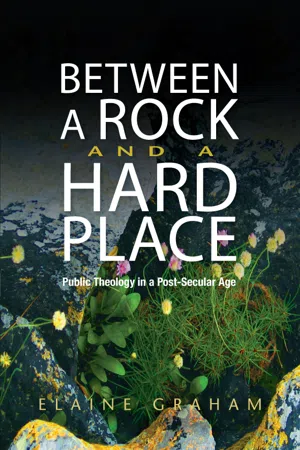
Between a Rock and a Hard Place
Public Theology in a Post-Secular Age
- 288 pages
- English
- ePUB (mobile friendly)
- Available on iOS & Android
About this book
Public theology is an increasingly important area of theological discourse with strong global networks of institutions and academics involved in it. Elaine Graham is one of the UK's leading theologians and an established SCM author. In this book, Elaine Graham argues that Western society is entering an unprecedented political and cultural era, in which many of the assumptions of classic sociological theory and of mainstream public theology are being overturned. Whilst many of the features of the trajectory of religious decline, typical of Western modernity, are still apparent, there are compelling and vibrant signs of religious revival, not least in public life and politics - local, national and global. This requires a revision of the classic secularization thesis, as well as much Western liberal political theory, which set out separate or at least demarcated terms of engagement between religion and the public domain. Elaine Graham examines claims that Western societies are moving from 'secular' to 'post-secular' conditions and traces the contours of the 'post-secular': the revival of faith-based engagement in public sphere alongside the continuing – perhaps intensifying – questioning of the legi¬timacy of religion in public life. She argues that public theology must rethink its theological and strategic priorities in order to be convincing in this new 'post-secular' world and makes the case for the renewed prospects for public theology as a form of Christian apologetics, drawing from Biblical, classical and contemporary sources.
Frequently asked questions
- Essential is ideal for learners and professionals who enjoy exploring a wide range of subjects. Access the Essential Library with 800,000+ trusted titles and best-sellers across business, personal growth, and the humanities. Includes unlimited reading time and Standard Read Aloud voice.
- Complete: Perfect for advanced learners and researchers needing full, unrestricted access. Unlock 1.4M+ books across hundreds of subjects, including academic and specialized titles. The Complete Plan also includes advanced features like Premium Read Aloud and Research Assistant.
Please note we cannot support devices running on iOS 13 and Android 7 or earlier. Learn more about using the app.
Information
The Turning of the Tide
Introduction
New Visibility
| Christian | 32 per cent | |
| Muslim | 23 per cent | |
| No affiliation | 16 per cent | |
| Hindu | 15 per cent | |
| Buddhist | 7 per cent | |
| ‘Folk Religion’ | 6 per cent | |
| Jewish | 0.2 per cent | |
| (Source: Pew Forum 2012, p. 9) | ||
| Summary by Region, 2010 | ||||||||||||||||||
| Region | Population (millions) | Per cent of Population | ||||||||||||||||
| Christian | Muslim | Unaff | Hindu | Budd | Folk | Other | Jewish | |||||||||||
| Asia-Pacific | 4,054.99 | 7.1 | 24.3 | 21.2 | 25.3 | 11.9 | 9.0 | 1.3 | <0.1 | |||||||||
| Europe | 742.55 | 75.2 | 5.9 | 18.2 | 0.2 | 0.2 | 0.1 | 0.1 | 0.2 | |||||||||
| Latin America/Caribbean | 590.08 | 90.0 | 0.1 | 7.7 | 0.1 | <0.1 | 1.7 | 0.2 | <0.1 | |||||||||
| Middle East/ North Africa | 341.02 | 3.7 | 93.0 | 0.6 | 0.5 | 0.1 | 0.3 | <0.1 | 1.6 | |||||||||
| N. America | 344.53 | 77.4 | 1.0 | 17.1 | 0.7 | 1.1 | 0.3 | 0.6 | 1.8 | |||||||||
| Sub-Saharan/ Africa | 822.72 | 62.9 | 30.2 | 3.2 | 0.2 | <0.1 | 3.3 | 0.2 | <0.1 | |||||||||
| World | 6,895.89 | 31.5 | 23.2 | 16.3 | 15.0 | 7.1 | 5.9 | 0.8 | 0.2 | |||||||||
| (Source: Pew Forum 2012, p. 50) | ||||||||||||||||||
Table of contents
- Between a Rock and a Hard Place
- Contents
- Acknowledgements
- Introduction: A Rock and a Hard Place
- Part 1 Post-Secular Society
- 1 The Turning of the Tide
- 2 The Unquiet Frontier
- Part 2 Post-Secular Public Theology
- 3 Lost in Translation?
- 4 Public Speaking
- 5 Crusades and Culture Wars
- Part 3 Public Theology as Christian Apologetics
- 6 Jews, Pagans, Sceptics and Emperors
- 7 The Apologetics of Presence
- Bibliography
- Index
- Index of Authors